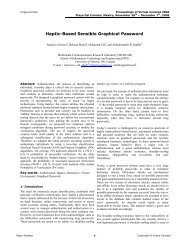Part-based PCA for Facial Feature Extraction and Classification
Part-based PCA for Facial Feature Extraction and Classification
Part-based PCA for Facial Feature Extraction and Classification
You also want an ePaper? Increase the reach of your titles
YUMPU automatically turns print PDFs into web optimized ePapers that Google loves.
advantage of the differences among expressions, that is, the<br />
differences between individuals which are useful <strong>for</strong> face<br />
recognition may become interference in facial expression<br />
recognition since individual differences must be neglected in<br />
facial expression recognition. Traditionally, <strong>PCA</strong> is applied<br />
in a whole face image which contains many individual<br />
differences. This happens to explain why <strong>PCA</strong> is commonly<br />
used in face recognition while few studies show it being used<br />
in facial expression recognition [19]. Another problem that is<br />
a h<strong>and</strong>icap <strong>PCA</strong> <strong>for</strong> facial expression recognition is that the<br />
features extracted from <strong>PCA</strong> are not the best features suitable<br />
<strong>for</strong> classification but <strong>for</strong> expressing the data set. Based on<br />
these two factors that might affect expression recognition<br />
results, we propose part-<strong>based</strong> <strong>PCA</strong> <strong>for</strong> facial feature<br />
extraction <strong>and</strong> apply a modified <strong>PCA</strong> reconstruction method<br />
<strong>for</strong> expression classification.<br />
2.2 <strong>Part</strong>-<strong>based</strong> <strong>PCA</strong><br />
To avoid the influence of personal differences, instead of<br />
applying <strong>PCA</strong> on the whole facial image, we attempt to apply<br />
<strong>PCA</strong> on part of the face image where only useful facial<br />
regions are analyzed. This can refine useful in<strong>for</strong>mation <strong>and</strong><br />
ab<strong>and</strong>on useless ones, such as the disturbance of facial <strong>for</strong>m<br />
<strong>and</strong> ratios of facial features. The most important areas in<br />
human faces <strong>for</strong> classifying expression are eyes, eyebrows<br />
<strong>and</strong> mouth. Other areas in the human face contribute little or<br />
even encumber facial expression recognition. In this section,<br />
we propose a new facial feature location approach call multistep<br />
integral projection <strong>for</strong> feature area detection. For each of<br />
the integral projection step, the location of the eyes <strong>and</strong><br />
mouth area is getting more <strong>and</strong> more accurate.<br />
The integral projection technique was originally propose by<br />
Kanade[20]. The basic idea of gray-level integral projection<br />
is to accumulate the sum of vertical gray-level from <strong>and</strong><br />
horizontal gray-level respectively. The vertical gray-level<br />
integral projection st<strong>and</strong>s <strong>for</strong> the variations on the horizontal<br />
direction of an image. The horizontal gray-level integral<br />
projection st<strong>and</strong>s <strong>for</strong> the variations on the vertical direction of<br />
an image. Suppose there is an image m*n. The gray-level of<br />
each pixel is I(x,y). Thus, the definition of the vertical<br />
projection function is<br />
S ( )<br />
x<br />
y x = <br />
y − 1<br />
I( x, y)<br />
The definition of the horizontal projection function is<br />
m<br />
x−1<br />
Sx( y) = I( x, y)<br />
Be<strong>for</strong>e employing integral projection to facial expression<br />
detection, we need to convert input image into binary image.<br />
Image binarization is one of the main techniques <strong>for</strong> image<br />
segmentation. It segments an image into <strong>for</strong>eground <strong>and</strong><br />
background. The image will only appear in two gray-levels:<br />
the brightest level 255 <strong>and</strong> the darkest level 0. The<br />
<strong>for</strong>eground contains in<strong>for</strong>mation of interest. The most<br />
important part in image binarization is the threshold selection.<br />
Image thresholding is a useful method in many image<br />
processing. We use a nonparametric <strong>and</strong> unsupervised<br />
method of automatic threshold selection, called the Otsu<br />
method [21]. This method has been widely used as the<br />
classical technique in thresholding tasks since it is not<br />
sensitive to non-uni<strong>for</strong>m illuminations. Gray-level histogram<br />
indicates the total pixels of an image at a gray-level, that is,<br />
the distribution of pixels of the image (see Fig 4). The main<br />
idea of Otsu is to dichotomize the gray-level histogram into<br />
two classes by a threshold level. The maximum value m of<br />
the variance σ between 0~K is the threshold we are looking<br />
<strong>for</strong>.<br />
Fig 4. The gray-level histogram<br />
Using the threshold, we convert the original picture into a<br />
binary image, that is, an image with pixel values 0 <strong>and</strong> 255,<br />
representing black <strong>and</strong> white respectively. The black is called<br />
the <strong>for</strong>eground which contains facial feature in<strong>for</strong>mation that<br />
we are interested in; while the white background will be<br />
ignored since it is useless in<strong>for</strong>mation.<br />
After image binarization, we make use of multi-step integral<br />
projection to obtain facial feature positions. The first step is<br />
applying horizontal integral projection on original binary<br />
image. Fig 5 shows the result of vertical <strong>and</strong> horizontal<br />
projection curves. Suppose I ( xy , ) is a gray value of an<br />
image, the horizontal integral projection in intervals [ y1, y<br />
2]<br />
<strong>and</strong> the vertical projection in intervals [ x 1<br />
, x 2<br />
] can be<br />
defined respectively as H ( y)<br />
<strong>and</strong> V( x ), thus we have:<br />
x2<br />
1<br />
H ( y) = I( x, y)<br />
x − x =<br />
2 1 x x1<br />
y2<br />
1<br />
V( x) = I( x, y)<br />
y − y =<br />
2 1 y<br />
The horizontal projection indicates the x-axis of the eyebrow,<br />
eyes, <strong>and</strong> mouth. Let x-axis of the eyes be the central point<br />
<strong>and</strong> double length from eyebrow to eye as the region, the<br />
result of the vertical projection indicates the y-axis of the left<br />
eye <strong>and</strong> right eye. Since the original integral projection<br />
curves are irregular, we use Bezier Curves [22, 23], which are<br />
used in computer graphics to model smooth curves at all<br />
scales. For any four points: Ax (<br />
A, y<br />
A)<br />
, B( xB, y<br />
B)<br />
,<br />
Cx (<br />
C, y<br />
C)<br />
, D( xD, y<br />
D)<br />
, it starts at Ax (<br />
A, y<br />
A)<br />
<strong>and</strong> ends<br />
at D( xD, y<br />
D)<br />
, the so-called end points. Cx (<br />
C, y<br />
C)<br />
,<br />
D( xD, y<br />
D)<br />
are called the control points. There<strong>for</strong>e, any<br />
coordinate ( xt, yt)<br />
in a curve is:<br />
x = x ⋅ t + x ⋅(1 − t) + 3 ⋅xc⋅(1 −t) ⋅ t + 3 ⋅x ⋅t⋅(1 −t)<br />
3 3 2 2<br />
t A B D<br />
y = y ⋅ t + y ⋅(1 − t) + 3 ⋅yc⋅(1 −t) ⋅ t + 3 ⋅y ⋅t⋅(1 −t)<br />
3 3 2 2<br />
t A B D<br />
y1<br />
101






